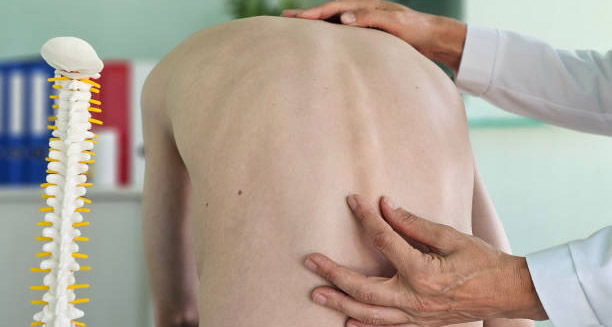A thorough and timely diagnosis of kyphosis is essential in determining the severity of spinal curvature and identifying any underlying causes or complications. The diagnosis of kyphosis usually starts with a detailed medical history and physical exam, followed by imaging and functional tests. Accurate diagnosis helps distinguish between types—postural, congenital, Scheuermann’s, or degenerative—and guides treatment and monitoring.
Doctors begin by asking about symptoms, family history, and related problems such as back pain, tiredness, or breathing trouble. Parents may notice changes in posture or height in children and teens. Knowing when symptoms began and if they are worsening helps decide if kyphosis is flexible (postural) or fixed (structural).
Physical Exam and Imaging in Diagnosis of Kyphosis
During the physical exam, the doctor observes the spine’s curve while the patient stands, bends forward, or lies down. In postural kyphosis, the curve often disappears when lying flat or standing straight. In structural kyphosis like Scheuermann’s or congenital types, the curve stays visible and does not correct with posture changes. The doctor also checks for uneven shoulder height, a prominent upper back, or an exaggerated spine curve.
To confirm the diagnosis of kyphosis, imaging tests are needed. A side-view X-ray is the first step. It measures the Cobb angle, which shows the degree of curvature. A Cobb angle over 40 degrees usually means kyphosis. In teens, a sharp curve with wedge-shaped vertebrae may indicate Scheuermann’s disease, while a smooth curve suggests postural causes.
Advanced imaging, such as MRI, may be done if doctors worry about spinal cord or nerve issues. MRI offers detailed pictures of the spinal cord, discs, and muscles, helping rule out tumors, cysts, or infections. CT scans are less common but useful for assessing congenital kyphosis or trauma-related problems.
Neurological and Bone Health Evaluation
Neurological exams are important if patients report numbness, tingling, or weakness. Reflexes, sensation, and muscle strength tests check for nerve or spinal cord compression. If signs of nerve damage appear, urgent imaging and referral to a spine specialist may follow.
In older adults with osteoporosis or fractures, bone density tests like DEXA scans help assess fracture risk. Early detection of bone loss can guide treatment to prevent worsening kyphosis and new fractures.
Pulmonary function tests may also be needed. Severe thoracic kyphosis can limit lung expansion. Spirometry or full lung function tests evaluate breathing capacity, especially in patients with shortness of breath or fatigue.
Special Cases and Monitoring
For children with suspected congenital kyphosis, early diagnosis is critical. These cases often progress fast and may need surgery to avoid deformity or nerve damage. Pediatric orthopaedic specialists manage diagnosis using X-rays, MRIs, and clinical checks.
After confirming kyphosis, classifying the type guides treatment. Postural kyphosis tends to be mild and reversible with exercise and posture correction. Scheuermann’s kyphosis is rigid and may require bracing or surgery. Degenerative kyphosis relates to aging spine changes and needs therapy, pain relief, and bone health support. Proper classification ensures treatment matches the patient’s age, symptoms, and needs.
Monitoring is key. Even after diagnosis, patients—especially growing kids—need regular follow-ups. X-rays every 6 to 12 months track changes. Adults with symptoms also require imaging to assess progression or complications.
It is vital to distinguish kyphosis from other spine conditions like scoliosis (sideways curve) or lordosis (inward curve). Sometimes patients have kyphoscoliosis, combining curves. Accurate diagnosis avoids wrong treatment and unnecessary discomfort, stressing the need for specialist care in complex cases.
Summary of Diagnosis of Kyphosis
In summary, the diagnosis of kyphosis involves a stepwise approach with clinical exams, imaging, and functional tests. Whether postural or structural, early and accurate diagnosis allows timely treatment, prevents complications, and supports long-term spine health. Modern tools and awareness give patients a better chance at maintaining quality of life through early care and ongoing management.


